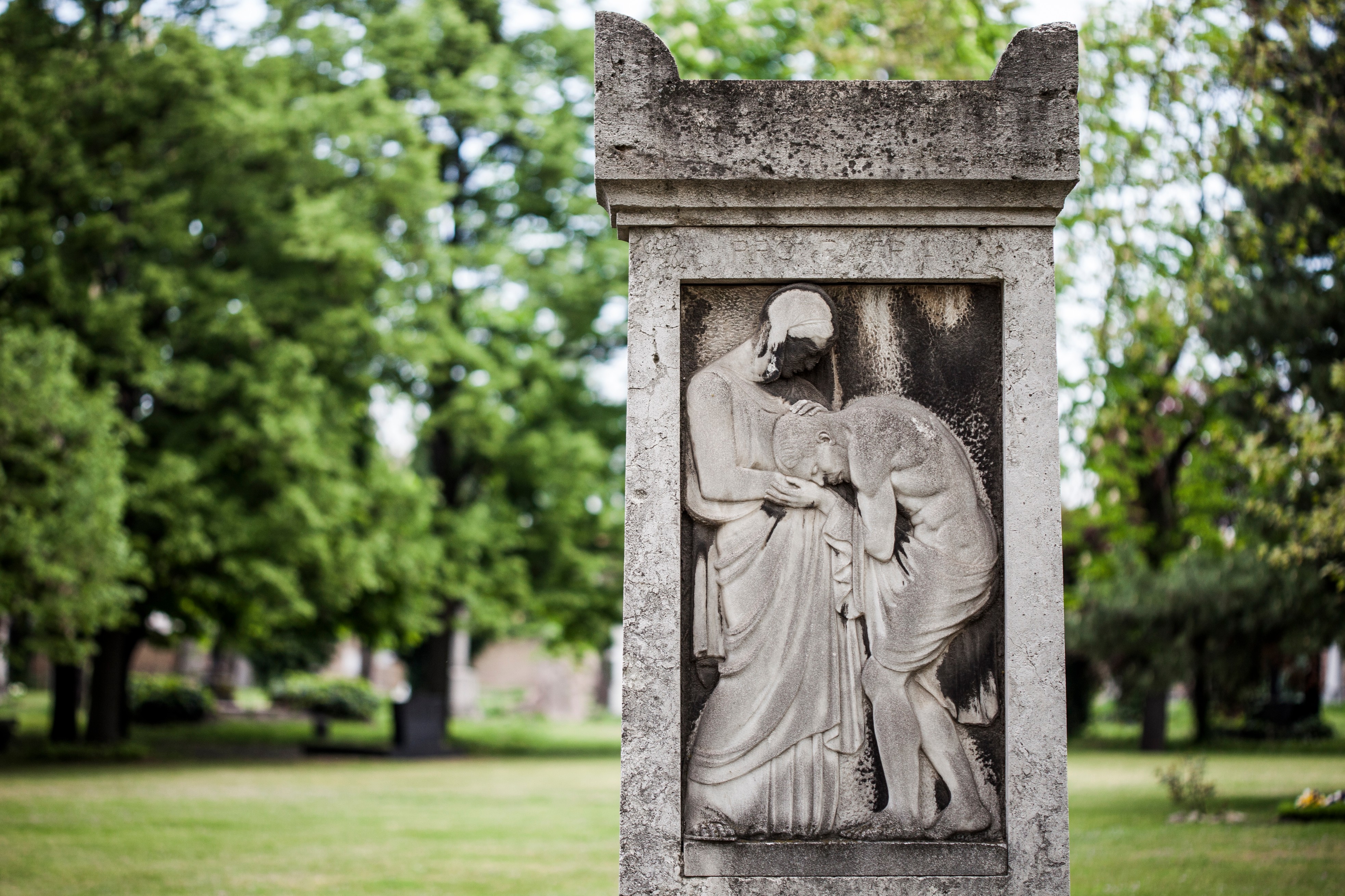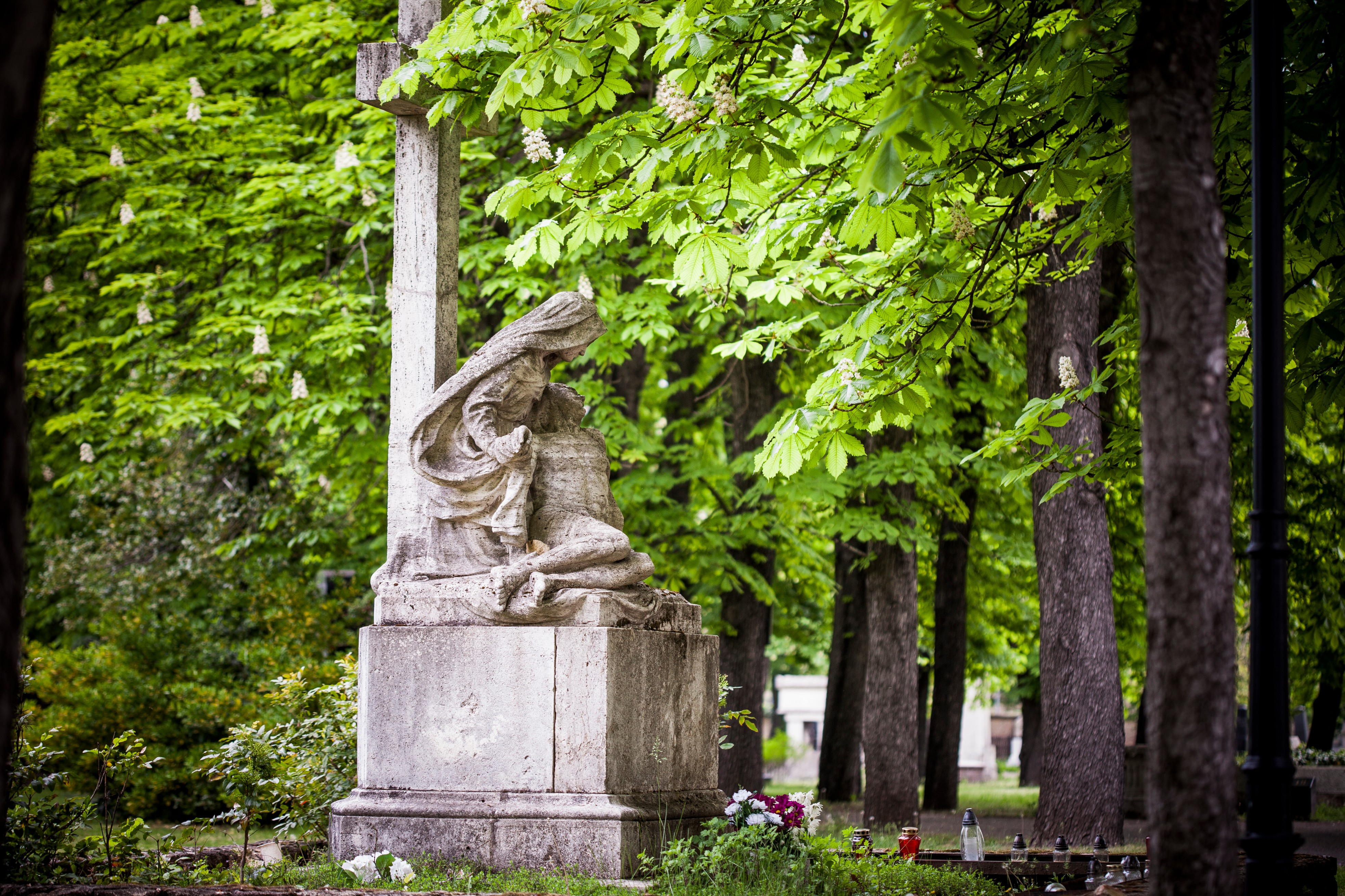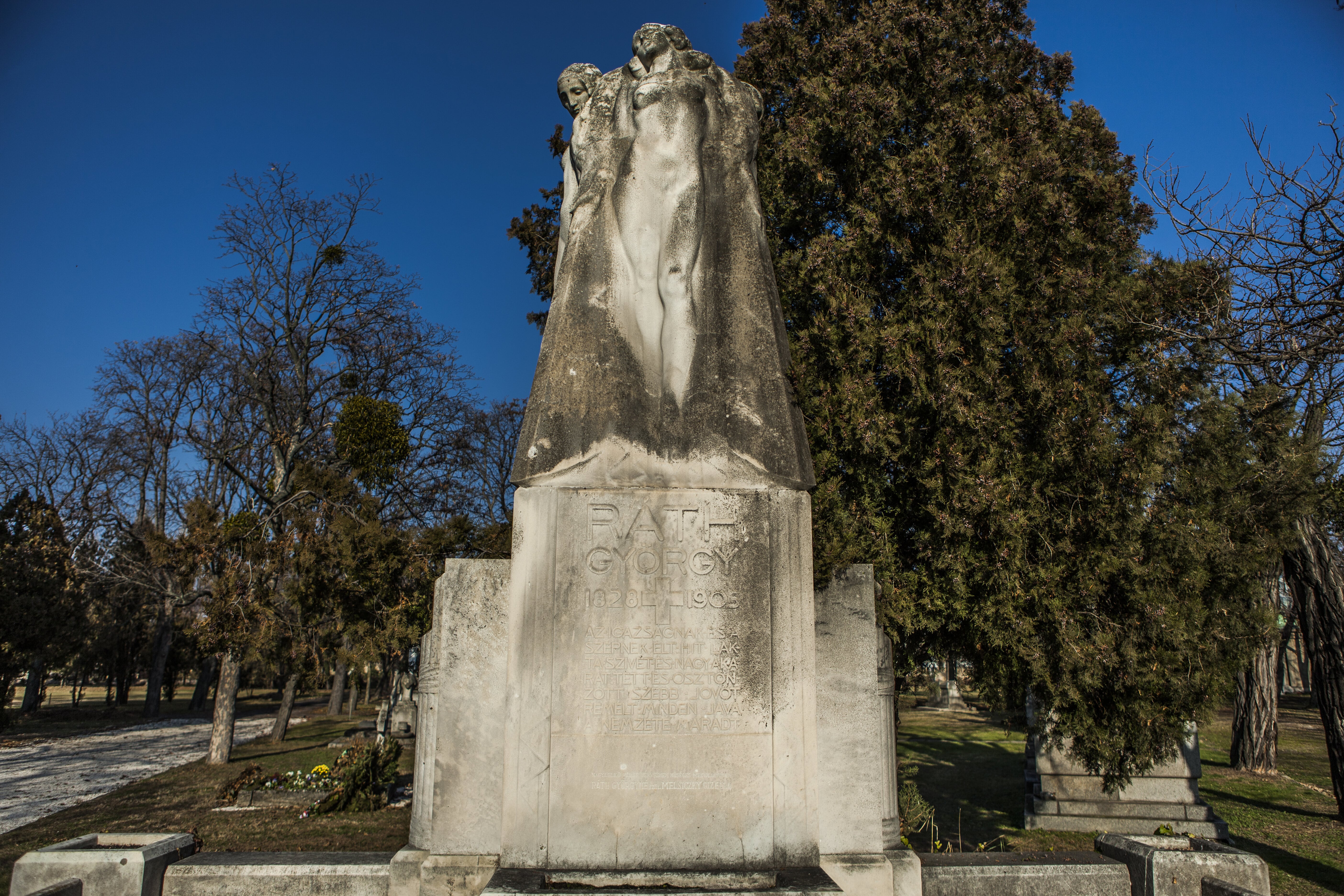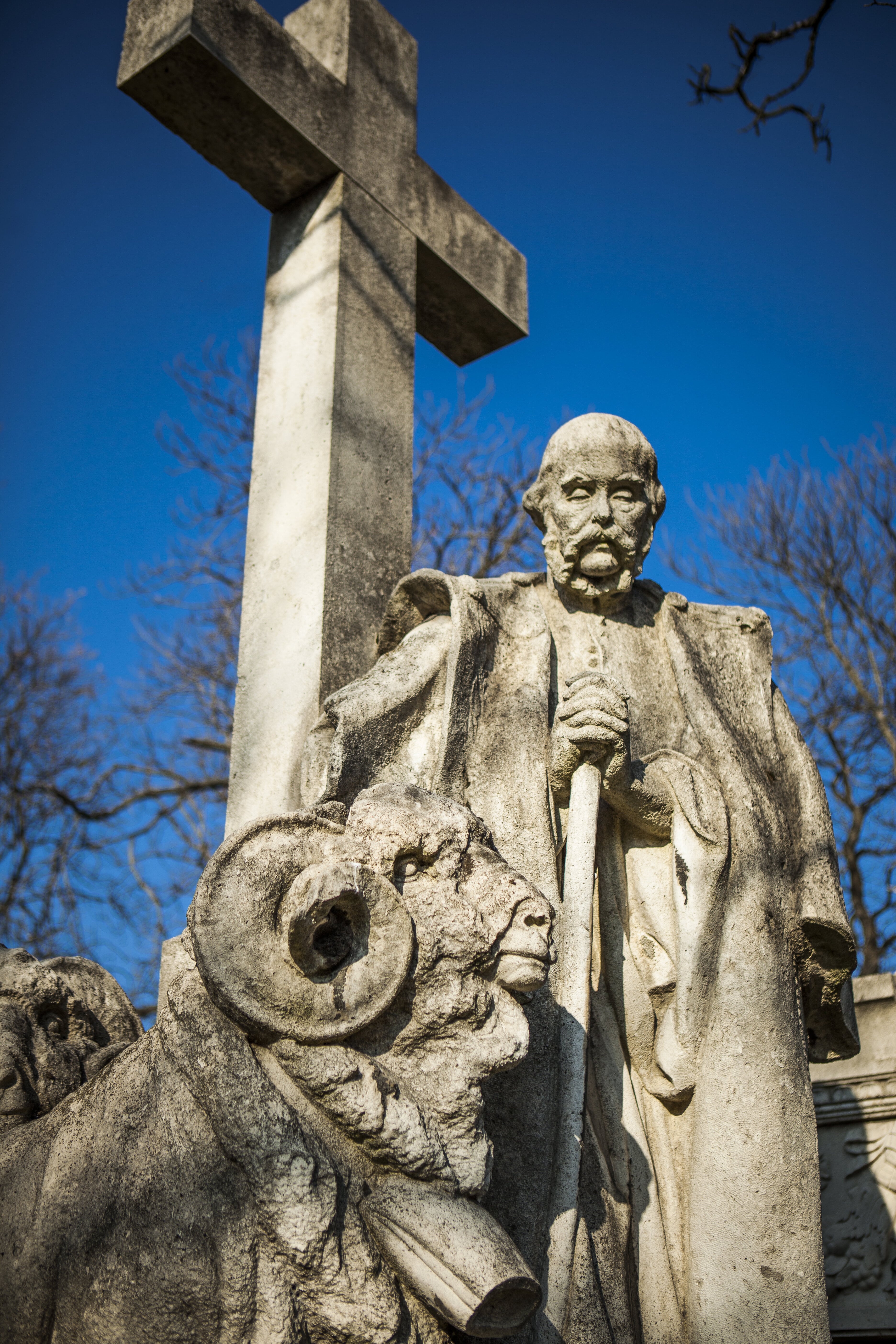
10. parcella
Plány Ervin síremléke, márvány, 1918 (10-1-81)
szobrász: Kisfaludi Strobl Zsigmond
A síremlék domborműve anyát és fiát ábrázolja, mint ahogy a sírban is együtt nyugszanak.
Plány Ervin a nagybányai festőtelep fiatal művésztehetségeinek egyike volt. Az ifjú művész nem sokkal bevonulása után az északi harctéren kapott sebesülésébe halt bele Budapesten, 1916 legelején. A hazai művészvilág első jelentős világháborús halottja volt, koporsóját a művészek kiváltságos szemfedőjével, a Munkácsy-lepellel borították.
 Az antik síremléket idéző sztélén egy nő és egy férfi: anya és fia látható, alakjaik teljesen kitöltik a felületet. Az ifjú gyermeki szeretettel hajol meg anyja előtt, annak jobb kezére hajtja fejét, míg az édesanya bal kezét szeretetteljesen ráhelyezi. A búcsúzás, az elszakadás pillanatának fájdalmas jelenete. A háborúba induló művész még rendelkezett elhunyt édesanyja síremlékéről, amelynek elkészítését Kisfaludi Strobl Zsigmondra bízta.
Az antik síremléket idéző sztélén egy nő és egy férfi: anya és fia látható, alakjaik teljesen kitöltik a felületet. Az ifjú gyermeki szeretettel hajol meg anyja előtt, annak jobb kezére hajtja fejét, míg az édesanya bal kezét szeretetteljesen ráhelyezi. A búcsúzás, az elszakadás pillanatának fájdalmas jelenete. A háborúba induló művész még rendelkezett elhunyt édesanyja síremlékéről, amelynek elkészítését Kisfaludi Strobl Zsigmondra bízta.
A pár évvel később elkészült dombormű már nemcsak az édesanya, hanem szeretett fiának is a síremléke lett. Az ábrázolás a 20. század kegyetlen eseményeinek újraértelmezett piétája: a fájdalomtól gyötört édesanya, aki a háborúban hősi halált halt fiát tartja kezei közt. Az alakok antikizáló viselete is az időtlenség érzetét kelti, korokon átívelő általános érvényű igazságot és érzéseket fejezi ki. A fiát elvesztő anya lepelbe bújtatott alakja Máriára is utal, a fiú meztelensége a kiszolgáltatottságot, az ártatlan áldozat szerepét jelképezi. A Pro Patria-felirat emlékeztet az ifjú halálának körülményeire.
Piéta, budakalászi kő, 1923 (10-1-sarok)
szobrász: Tóth István
Az 1920-as évek elején határozták el a köztemetők közösségi kegyeleti helyeinek művészi értékű emlékművekkel való megjelölését. A Kerepesi temető közösségi kegyeleti helyét jelölő műalkotás megformálására Tóth István szobrászművészt kérték fel, aki egyik korábbi, Nagyváradra készített Piéta-szoborcsoportjának másodpéldányát tervezte megfaragni.
 Az elkészült művet 1924-ben állították fel a főbejárathoz közel eső kápolna melletti területen. Az 1960-as évek második felében helyezték át a szobrot ma is látható helyére, a bal oldali Árkádsor előtti parcella sarkára.
Az elkészült művet 1924-ben állították fel a főbejárathoz közel eső kápolna melletti területen. Az 1960-as évek második felében helyezték át a szobrot ma is látható helyére, a bal oldali Árkádsor előtti parcella sarkára.
A szobrászművész Nagyváradon látható Piétáját a város akkori püspöke, Szmrecsányi Pál rendelte meg és ajándékozta a városnak. A szoborcsoportot 1906-ban állították fel a váradolaszi Barátok temploma előtt, később a templom kertjébe helyezték át, ahol jelenleg is áll.
A Piéta kompozíciója, a keresztről levett, halott fiát ölében tartó és sirató anya ábrázolása a 14. század végén jelenik meg a művészetben. Bár a Szentírás nem említi, hogy Mária ölében tartotta volna halott fiát, e jelenet a szakrális tárgyú szobrászat és festészet egyik központi témája évszázadok óta.
A Tóth István alkotta Piéta-szobor Michelangelo 1499-ből való alkotásának 20. századi utánérzését kelti. Mária bőséges ruházatban tarja kezei közt halott gyermekének meztelen testét. Krisztus csuklóját jobb kezében, fejét bal tenyerében tartja, miközben élettelen fiát magához vonva gyászolja. A fájdalmas anya témáját a reneszánsz korban népszerű szerkesztési elv alapján egy képzeletbeli háromszögbe komponálta a művész, az egység és a kiegyensúlyozottság érzetét keltve.
Sculptura – Pictura – Architectura, Ráth György síremléke, márvány, 1907–1911 (10/1/1-1)
Szobrász: Maróti Géza
Ráth György síremléke a hazai szecessziós temetői művészet egyik kiemelkedő példája.
 A síremlék kompozíciója az Iparművészeti Múzeum hajdani megszervezőjének és igazgatójának a művészetek iránti szeretetét fejezi ki. A talapzaton megjelenő három nőalak a művészet három ágát, a festészetet, a szobrászatot és az építészetet jeleníti meg. Elrendezésük az ókori művészetből ismert hármasalakú Hekaté-ábrázolásokat idézi. A márványtömbből kibontakozó aktok az anyagból megszülető szépség, a teremtő művészet erejének kifejezői, akik a dicsőséget jelképező babérkoszorút tartják az elhunyt fölé. Az építészetet megtestesítő nő lábánál egy kéttornyú építmény, a szobrászatot jelképezőnél egy faragott fej utal a képviselt művészeti ágra. A kompozíció közvetlen előzményének Leonardo Bistolfi olasz szobrász Az anyagból kiszabaduló szépség című egyalakos műve tekinthető, amelyet az alpesi hegyek festőművésze, Giovanni Segantini tiszteletére faragott, és a festőművész nevét viselő múzeum előtt állítottak fel.
A síremlék kompozíciója az Iparművészeti Múzeum hajdani megszervezőjének és igazgatójának a művészetek iránti szeretetét fejezi ki. A talapzaton megjelenő három nőalak a művészet három ágát, a festészetet, a szobrászatot és az építészetet jeleníti meg. Elrendezésük az ókori művészetből ismert hármasalakú Hekaté-ábrázolásokat idézi. A márványtömbből kibontakozó aktok az anyagból megszülető szépség, a teremtő művészet erejének kifejezői, akik a dicsőséget jelképező babérkoszorút tartják az elhunyt fölé. Az építészetet megtestesítő nő lábánál egy kéttornyú építmény, a szobrászatot jelképezőnél egy faragott fej utal a képviselt művészeti ágra. A kompozíció közvetlen előzményének Leonardo Bistolfi olasz szobrász Az anyagból kiszabaduló szépség című egyalakos műve tekinthető, amelyet az alpesi hegyek festőművésze, Giovanni Segantini tiszteletére faragott, és a festőművész nevét viselő múzeum előtt állítottak fel.
A sírszobor mintáját 1909-ben a Velencei Biennálé magyar pavilonjának iparművészeti termében állították ki, míg a kész márványszobrot 1911-ben emelték a sírhant fölé. A síremlék két oldalán látható vesszőnyalábok (fasces), amelyek a római korban eredetileg a legfőbb magistratusok hivatali és büntetőhatalmának jelképei voltak, Ráth György bírói tevékenységére utalnak. A síremlék homlokzatára Lippich Elek költő sorait vésték: „Az igazságnak és a szépnek élt. Hit lakta szívét és nagy akarat. Tett és ösztönzött, szebb jövőt remélt. Minden java a nemzeté maradt.”
Zielinski Szilárd síremlékének domborművei, bronz, 1932 (10/1/1-2)
Szobrász: Bory Jenő
Építész: Walder Gyula
A lengyel származású Zielinski Szilárd volt az első magyarországi mérnök doktor, miután a Műegyetem 1901-ben megkapta a doktori cím adományozásának jogát. A neves  tudóshoz fűződik a vasbeton széles körben való hazai alkalmazása, később pedig az út- és vasútépítéstan professzora lett.
tudóshoz fűződik a vasbeton széles körben való hazai alkalmazása, később pedig az út- és vasútépítéstan professzora lett.
Síremlékének építészeti tervei Walder Gyula, plasztikai díszítése pedig egykori tanítványa, Bory Jenő munkája. Zielinski Szilárd síremléke az egykor élt mérnök életét idézi meg: portréja a tudós emlékét, az alkotásairól készült domborművek pedig az életművét reprezentáló alkotásait. A szürke gránit szarkofág négy oldalán lévő bronzreliefek közül három egy-egy műszaki építményt ábrázol. Egyikén a Brassó-Fogarasi völgyhíd látható, amely az egyik büszkesége volt a tervezőnek, hisz e hidat a legkevesebb anyag felhasználásával, a lehető legkisebb költséggel, legszebb formában, mégis a legnagyobb hordképességgel sikerült megépíteni 1908-ban, amely az akkori világ legnagyobb ívnyílású völgyhídjának számított. A másik dombormű az 1911-re elkészült margitszigeti víztornyot örökíti meg, amely a sziget növekvő és zavartalan vízellátását biztosította, ugyanakkor pedig kilátótoronyként is működött. A harmadik dombormű az 1928-ban átadott Budapesti vámmentes kikötőt ábrázolja, amelynek megtervezését több évtizedes tanulmányok és előmunkálatok előzték meg. A szarkofág főhomlokzatán elhelyezkedő dombormű Zielinski Szilárd balra néző portréját ábrázolja.
Pállik Béla síremléke, mészkő, 1933 (10/1/1-7)
Szobrász: ifjabb Vastagh György
25 évvel a festőművész halála után került sor a különleges, nem mindennapi síremlék felavatására. Pállik Bélát már ifjúkora óta leginkább az állatok megfigyelése és ábrázolása érdekelte, különösen a birkákat festette meg szívesen. Az országos ismertségre és népszerűségre szert tevő „birkapiktornak” is nevezett festőművész emlékét egy út menti feszület alatt álló pásztor és nyája idézi. A botjára  támaszkodó, kezét imára kulcsoló, maga elé tekintő öreg pásztor arcán gyász tükröződik, a feszület alatt az elhunyt lelkéért imádkozik szeretett állatai közt. Nyáját három birka jeleníti meg, gazdájukat körbevéve állnak egymás mellett.
támaszkodó, kezét imára kulcsoló, maga elé tekintő öreg pásztor arcán gyász tükröződik, a feszület alatt az elhunyt lelkéért imádkozik szeretett állatai közt. Nyáját három birka jeleníti meg, gazdájukat körbevéve állnak egymás mellett.
A fentiekből következik, hogy Vastagh Györgyöt, a legnagyobb állatszobrászként számontartott művészt kérték fel a Pállik Béla méltó síremlékének elkészítésére. A sírszobrot a Műcsarnok 1933-as képzőművészeti kiállításán is bemutatták. A nemzeti képzőművészeti kiállításra kitűzött Nagy Aranyérmet a kultuszminiszter és a Képzőművészeti Társulat által delegált bizottság egyhangúlag ítélte oda a szobrászművésznek Pállik Béla síremléke című kompozíciójáért.
(Az Állami Aranyérem a legmagasabb művészeti kitüntetés volt, amelyet Trefort Ágost vallás- és közoktatásügyi miniszter 1886-ban, a Képzőművészeti Társulat akkori 25 éves jubileuma alkalmából és a társulat érdemeinek a magyar kormány részéről történő elismeréseként alapított.)
Tomb of Ervin Plány, marble, 1918 (10-1-81)
Sculptor: Zsigmond Kisfaludi Strobl
The tomb relief depicts the mother and the son since they both rest in the same grave.
Ervin Plány was one of the gifted young painters of the Nagybánya artist colony. The artist died of a combat wound received in the northern battlefield shortly after his mobilization. He passed away in Budapest in early 1916. He was the Hungarian art world’s first significant victim of the war and his coffin was draped with the Munkácsy shroud used to denote artists of excellence.
A woman and a man are visible on the stela recalling tombs of Antiquity: the entire surface is taken up with the figures of mother and son. The young man is bending forward before his mother with the love of a child, touching his forehead to her right hand while his mother places her left hand lovingly on his head. It is the painful scene of the moment of parting. The artist on his way to war had already arranged the tomb for his deceased mother, which he commissioned Zsigmond Kisfaludi Strobl to make.
 The relief produced a few years later became the tomb not only of the mother but her beloved son, too. The depiction is the reinterpreted pieta of the barbarities of the 20th century: the suffering mother holding her son who died a hero’s death in the war. The Antiquity dress of the figures also evokes a sense of timelessness, expressing a universal truth and emotions that span the ages. The shrouded figure of the mother who has lost her son refers to Mary, while the son’s naked state symbolizes vulnerability, the role of the innocent victim. The inscription Pro Patria reminds the viewer of the circumstances surrounding the death of the young man.
The relief produced a few years later became the tomb not only of the mother but her beloved son, too. The depiction is the reinterpreted pieta of the barbarities of the 20th century: the suffering mother holding her son who died a hero’s death in the war. The Antiquity dress of the figures also evokes a sense of timelessness, expressing a universal truth and emotions that span the ages. The shrouded figure of the mother who has lost her son refers to Mary, while the son’s naked state symbolizes vulnerability, the role of the innocent victim. The inscription Pro Patria reminds the viewer of the circumstances surrounding the death of the young man.
Zsigmond Kisfaludi Strobl (Alsórajk, 1 July 1884 – Budapest, 14 August 1975)
Zsigmond Kisfaludi Strobl created his sculptures under various political systems and in the spirit of different ideologies. He worked for the British royal family, Miklós Horthy, Stalin and Mátyás Rákosi.
He showed an interest in sculpture even in his childhood, fashioning his first works from the soft inner part of loaves. His talent won him many prizes, from which he was able to finance study tours in Europe. Cities he visited included Vienna, Rome, Venice, Florence, Paris and Brussels. Similarly to his fellow artists, he too was a student of the School of Drawing, predecessor of today’s University of Fine Art.
His first collective exhibition was organized in 1909, when the state purchased his work Finálé for the Museum of Fine Art. His works from this time reflect the contemporary art aspirations of the time. In 1913, he won his first commission for a public statue: the figure of Mihály Horváth made for the town of Szentes. During the First World War he was drafted into the press corps, which allowed him to meet artists such as Bertalan Pór, Ödön Márffy, László Mednyánszky, József Rippl-Rónai and Oscar Kokoschka.
In 1918, in the space of just a few weeks, he made the figure Aster Soldier, as well as his work Archer located in City Park, copies of which made it to the United States, the Hermitage Museum and even Indonesia. Following this he took part in the artistic life of the short-lived Hungarian Soviet Republic, then he became a representative figure in the interwar period, which is when his artistic career truly burgeoned. In the 1920s he worked at the ceramic studio of Miklós Ligeti in Angyalföld.
In 1931, he completed one of his largest public compositions, a statue of Prince St. Emeric, made in sentimental neo-Baroque style. However, The Hungarian Hussar erected a year later exudes Rococo elegance, making it suitable for mass production at the Herend porcelain factory.
After the Second World War he travelled to the Soviet Union several times while his artistic career continued unabated. In 1945, he was commissioned with making the Liberation Monument on Gellért Hill, and in 1952 he received a request to produce the Kossuth statue next to the National Assembly. (Today, this statue can be viewed in the square behind the Ludovika Academy.)
He was particularly sought after as a portrait sculptor. Seventy-two of his works can be found in England, in collections, private hands and even in the palace of the royal family. His models came from the highest echelons of politics and the arts, both here in Hungary and abroad. His oeuvre spanning several political systems comprises some 2600 portraits and more than 50 public works. Zsigmond Kisfaludi Strobl was awarded the Kossuth Prize twice, in 1950 and in 1953.
Aside from his work introduced above, many tombs located in Fiumei Road Cemetery also belong to his incredibly rich oeuvre.
Pieta, Budakalász stone, 1923 (10-1-corner)
Sculptor: István Tóth
At the beginning of the 1920s, a decision was reached to mark communal places of respect and piety in public cemeteries with monuments of artistic value. Sculptor István Tóth was commissioned with the creation of a work of art marking Kerepesi cemetery’s communal place of respect. He planned to carve a copy of his Pieta sculptural ensemble made earlier for the city of Oradea.
The work was erected in 1924 in the area adjacent to the chapel close to the main entrance. In the second half of the 1960s the statue was relocated to its present-day position, on the corner of the plot in front of the left-hand Arcade.
The then bishop of Oradea, Pál Szmrecsányi, commissioned the sculptor to make the Pieta that can be seen in the city. He then donated it to Oradea. The ensemble was initially erected in 1906 in front of the Friary Church and later it was moved to the church garden where it can be seen today.
The Pieta composition depicting the grieving mother holding in her arms her dead son taken down from the cross appeared in art in the late 14th century. Although the Scriptures make no mention of Mary cradling her dead son, this scene has been one of the central themes of religious sculpture and painting for centuries.
The István Tóth Pieta sculpture evokes a 20th century sense of the famous Michelangelo work dating from 1499. Mary holds in her hands the naked body of her dead child. She bears Christ’s wrist in her right hand, his head on her left arm while she mourns as she holds close her lifeless son. The artist composed the theme of the grieving mother on the basis of the structural principle popular during the Renaissance i.e. a notional triangle to give an impression of unity and balance.
István Tóth (Szombathely, 9 November 1861 ̶ Budapest, 12 December 1934)
Born in Szombathely, the artist became acquainted with the art of wood carving as a young man in his father’s carpentry shop, primarily in the course of helping him make wooden sculptures. This is where he reached a decision to become a sculptor. He lived in Vienna for nearly a decade, he enrolled at the Vienna Academy of Sculpture and after graduating he returned to Budapest where he settled. First he assisted Alajos Stróbl in his studio in Castle Garden Bazaar and after being appointed teacher of sculpting at the School of Modelling he took over the studio and worked there until the end of his life. Alajos Stróbl acted as patron to the young, gifted artist moving to Buda, and this resulted in him receiving several commissions. This is how he came into contact with Lőrinc Schlauch, bishop of Oradea, from whom he received his first important commissions. The whole-figure seated statue of Bishop Ferenc Szaniszló erected in 1896 brought him national fame. The bishop of Oradea commissioned him with the completion of several other statues: the whole-figure statue of St. Ladislaus, the main altar of the Cathedral and the Pieta sculpture that can be seen in the garden of the Friary Church. His memory is preserved through several works in his hometown, Szombathely. Works of his defining the cityscape include the bronze of the former minister of justice in the Andrássy government, Boldizsár Horváth, and a seated statue of Bishop János Szily. István Tóth made the gilded herm preserving the skull relic of St. Martin, which is in one of the sanctuaries of the Cathedral of Our Lady of the Visitation. Budapest has similarly been enhanced with many of his works, he made statues for the façade and chambers of the National Assembly, the pediment of Vajdahunyad Castle in City Park, and for the Royal Palace. He was commissioned with making one of the ten statues ordered by the king to be erected in the city, that of the figure of János Hunyadi. The whole-figure bronze of the military leader stands on Hunyadi János Road under Fisherman’s Bastion. His reputation was such that the sculptor was elected president of the Association of Hungarian Fine Artists in 1902.
Szombathely remained closest to the heart of István Tóth right to the end of his life and he frequently travelled there to visit the grave of his parents. The artist was buried in Farkasréti Cemetery but in compliance with his wishes he was reinterred in his hometown, where he lies in eternal rest in the undercroft of the Salesian House.
Grave of Lajos Thallóczy, limestone, 1918 (10/1-1-14)
Sculptor: János Horvai
Lajos Thallóczy (1857–1916), as the first Hungarian researcher of the history of the South Slav peoples, played a significant role in shaping the Balkan policy of the Austro-Hungarian Monarchy. From 1901, he was responsible for educational and cultural affairs of Bosnia-Hercegovina that had been brought under the control of the Austro-Hungarian Monarchy, and in 1915, during the First World War, he was civil governor of occupied Serbia. He died in the Herceghalom rail disaster on his return from the state funeral of Franz Josef. His grave commemorates the founder of Balkan research in Hungary and the politician for the region with two male figures wearing different folk costume positioned either side of the sarcophagus. The slumped figure on the right depicts an anguished Hungarian peasant, the other a Bosnian in mourning with face turned towards the coffin. Their sorrowful figures express a common pain and mourning, and their hands joined on the top of the sarcophagus exemplify a shared destiny. Archduke Albrecht himself paid a visit to the sculptor’s studio to view the progress of the work in summer 1918. A plaster model of the composition appeared at an exhibition arranged by the arts group of the Guilds (Hungarian Fine Artists’ Circle) staged in the National Salon in 1918, and at the Winter Show organized by the Kunsthalle in 1919, where it was cited as the Thallóczy memorial of ‘interesting concept’. The memorial was erected over the mortal remains in 1920; it is likely its inauguration was not widely publicized due to the tragic course of political events.
Vissza a szoborpark listára